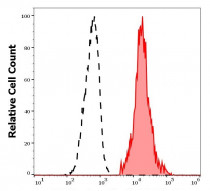ARG65450
anti-CD42a antibody [GR-P]
anti-CD42a antibody [GR-P] for Flow cytometry and Human,Dog
Immune System antibody
Overview
| Product Description | Mouse Monoclonal antibody [GR-P] recognizes CD42a |
|---|---|
| Tested Reactivity | Hu, Dog |
| Tested Application | FACS |
| Specificity | The mouse monoclonal antibody GRP (also known as GRPP) recognizes CD42a (glycoprotein 9), a 22 kDa transmembrane protein constitutively expressed on megakaryocytes and platelets. HLDA IV.; WS Code P 35 |
| Host | Mouse |
| Clonality | Monoclonal |
| Clone | GR-P |
| Isotype | IgG1 |
| Target Name | CD42a |
| Antigen Species | Human |
| Immunogen | Human acute lymphoblastic leukemia cells |
| Conjugation | Un-conjugated |
| Alternate Names | Glycoprotein 9; CD antigen CD42a; CD42a; GPIX; GP-IX; Platelet glycoprotein IX |
Application Instructions
| Application Suggestion |
|
||||
|---|---|---|---|---|---|
| Application Note | * The dilutions indicate recommended starting dilutions and the optimal dilutions or concentrations should be determined by the scientist. |
Properties
| Form | Liquid |
|---|---|
| Purification | Purified from cell culture supernatant by protein-A affinity chromatography. |
| Purity | > 95% (by SDS-PAGE) |
| Buffer | PBS (pH 7.4) and 15 mM Sodium azide |
| Preservative | 15 mM Sodium azide |
| Concentration | 1 mg/ml |
| Storage Instruction | For continuous use, store undiluted antibody at 2-8°C for up to a week. For long-term storage, aliquot and store at -20°C or below. Storage in frost free freezers is not recommended. Avoid repeated freeze/thaw cycles. Suggest spin the vial prior to opening. The antibody solution should be gently mixed before use. |
| Note | For laboratory research only, not for drug, diagnostic or other use. |
Bioinformation
| Database Links | |
|---|---|
| Gene Symbol | GP9 |
| Gene Full Name | glycoprotein IX (platelet) |
| Background | CD42a, also known as Glycoprotein 9 (GPIX), composes together with GPIb alpha, GPIb beta and GPV the GPIb-IX-V receptor complex critical in the process of platelet-rich thrombus formation by tethering the platelet to a thrombogenic surface. CD42b binds to von Willebrand factor (VWF) exposed at a site of vascular injury, as well as to thrombin, coagulation factors XI and XII, high molecular wight kininogen, TSP-1, integrin Mac-1 and P-selectin. Defects in the gene encoding CD42a are a cause of Bernard-Soulier syndrome, also known as giant platelet disease. These patients have unusually large platelets and have a clinical bleeding tendency. |
| Function | The GPIb-V-IX complex functions as the vWF receptor and mediates vWF-dependent platelet adhesion to blood vessels. The adhesion of platelets to injured vascular surfaces in the arterial circulation is a critical initiating event in hemostasis. GP-IX may provide for membrane insertion and orientation of GP-Ib. [UniProt] |
| Research Area | Immune System antibody |
| Calculated MW | 19 kDa |
Images (2) Click the Picture to Zoom In
-
ARG65450 anti-CD42a antibody [GR-P] FACS image
Flow Cytometry: Human peripheral blood stained with ARG65450 anti-CD42a antibody [GR-P] at 1 µg/ml dilution, followed by PE-conjugated Goat anti-Mouse antibody.
-
ARG65450 anti-CD42a antibody [GR-P] FACS image
Flow Cytometry: Separation of human thrombocytes (red-filled) from CD42a negative lymphocytes (black-dashed). Human peripheral whole blood stained with ARG65450 anti-CD42a antibody [GR-P] at 1 µg/ml dilution, followed by PE-conjugated Goat anti-Mouse antibody.









